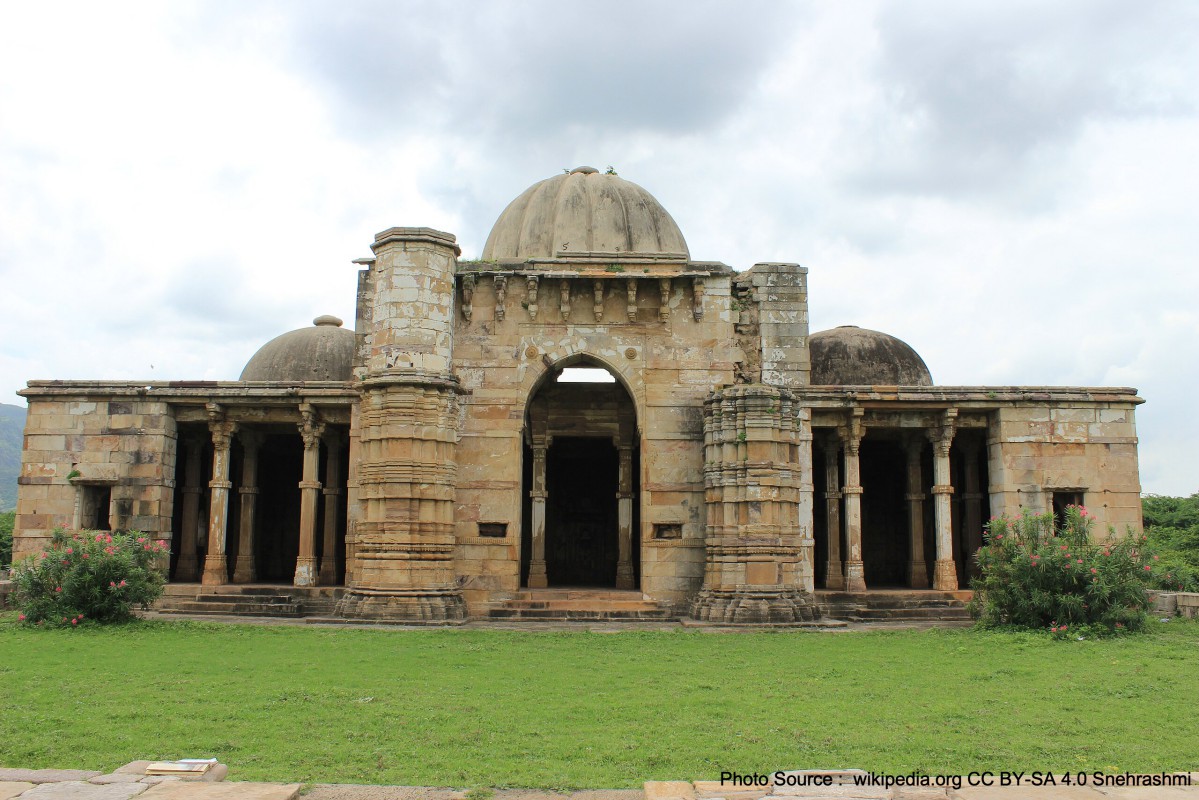Champaner-Pavagadh Archaeological Park
A cluster of predominantly unexcavated archaeological, historic, and living cultural heritage properties nestled in a remarkable landscape.

Champaner
Lila Gumbaj Ki Masjid, built on a high plinth, has a frontage with an arched entrance at the centre flanked by two lateral arches.
A
concentration of largely unexcavated archaeological, historic and living cultural heritage properties cradled in an impressive landscape which includes prehistoric (chalcolithic) sites, a hill fortress of an early Hindu capital, and remains of the 16th-century capital of the state of Gujarat.The site also includes, among other vestiges, fortifications, palaces, religious buildings, residential precincts, agricultural structures and water installations, from the 8th to 14th centuries.
The Kalikamata Temple on top of Pavagadh Hill is considered to be an important shrine, attracting large numbers of pilgrims throughout the year. The site is the only complete and unchanged Islamic pre-Mughal city.
Champaner-Pavagadh Archaeological Park, located in the Panchmahal District of Gujarat State in north-western India, features a concentration of archaeological, historical, and living cultural heritage properties cradled in an impressive landscape. Focused on Pavagadh Hill, a volcanic formation that rises 800 m above the surrounding plains, the property includes the remains of settlements dating from the prehistoric to medieval periods, the latter represented by a hill-fortress of an early (14th-century) Hindu capital and the remains of an Islamic state capital founded in the 15th century. The large property, comprised of 12 separate areas, contains the remains of fortifications, palaces, religious buildings, residential precincts, and water-retaining installations, as well as the living village of Champaner.
This area was conquered in the 13th century by the Khichi Chauhan Rajputs, who built their first settlement on top of Pavagadh Hill and fortification walls along the plateau below the hill. The earliest built remains from this period include temples, and amongst the important vestiges are water-retention systems. The Turkish rulers of Gujarat conquered the hill-fortress in 1484. With Sultan Mehmud Begda’s decision to make this his capital, the most important historic phase of this site began. The settlement of Champaner at the foot of the hill was rebuilt and remained the capital of Gujarat until 1536, when it was abandoned.
Except for the structural remains of the main buildings and forts, most parts of the capital city remain buried and unexcavated, though the planning and integration of the essential features of a city – royal estates, utilities, religious edifices, and spaces – can be seen and interpreted. Champaner-Pavagadh’s 14th-century temples and water-retaining installations, together with the later capital city’s religious, military, and agricultural structures, represent both Hindu and Muslim architecture. Champaner’s importance as a capital and residence of a sultan are best illustrated in the Great Mosque (Jama Masjid), which became a model for later mosque architecture in India.
At Champaner, the land, the people, and the built heritage are each components of a complex, and dynamic process. The Brahmanical temple of Kalika Mata (the guardian goddess of the hill) atop Pavagadh Hill is an important living shrine, attracting a large number of pilgrims from Gujarat and other parts of the country throughout the year.
Note : The above description of Champaner-Pavagadh Archaeological Park is by UNESCO website (CC-BY-SA IGO 3.0).
Champaner:
Champaner is known for its archaeological and historical significance. The city has a rich heritage with well-preserved structures, many of which date back to the 16th century. The UNESCO-listed Champaner-Pavagadh Archaeological Park includes a concentration of archaeological, historic, and living cultural heritage properties. Visitors to Champaner can explore ancient structures, forts, mosques, and other architectural marvels that reflect the city's diverse cultural influences.
Pavagadh Hill:
Pavagadh is a hill located near Champaner and is an integral part of the archaeological park. The hill is crowned with the historic Kalika Mata Temple, dedicated to the Goddess Kali. Pilgrims and tourists often undertake a trek to the summit of Pavagadh to visit the temple and enjoy panoramic views of the surrounding landscape. The Pavagadh Hill and the Kalika Mata Temple are not only significant for their religious importance but also contribute to the overall charm of the Champaner-Pavagadh
List of major attractions to cover in the itineary:
Champaner
Pavagadh hill
How to reach Champaner-Pavagadh Archaeological Park
By Air:
The nearest airport to Champaner-Pavagadh Archaeological Park is Vadodara Airport (approximately 42 kilometers away). From the airport, you can hire a taxi or use other local transportation to reach the archaeological site.
By Train:
The nearest major railway station is Vadodara Junction (approximately 47 kilometers away). Vadodara is well-connected to major cities in India. From Vadodara Junction, you can hire a taxi or use local transportation to reach Champaner-Pavagadh Archaeological Park.
[#road]By Road:
Champaner-Pavagadh Archaeological Park is well-connected by road. You can reach the park by hiring a taxi, using private transportation, or taking a state bus from nearby cities. The park is approximately 150 kilometers from Ahmedabad, and the journey offers picturesque views.
Take NH756 that goes around the area. From Vadodara take the Vadodara-Halol highway (about 50km).
| Helical stepped well |
|---|
| Sakar Khan's Dargah |
| City Gate near Kasbin Talao |
| Citadel walls |
| City walls at south-east corner of the citadel going up the hill |
| East and South Bhadra Gates |
| Sahar ki Masjid (Bohrani) |
| Three cells inside the citadel wall between Sahar ki Masjid the local fund Dharmashala |
| Mandvi or Custom House |
| Jami Masjid |
| Stepwell north of Jama Masjid |
| Kevda Masjid and Cenotaph |
| Tomb with a big dome in the centre and small corner domes on way to Khajuri Masjid near Wada Talao |
| Cenotaph of Kevda Masjid |
| Nagina Masjid |
| Cenotaph of Nagina Masjid |
| Lila Gumbaz ki Masjid, Chapaner |
| Kabutarkhana Pavilion on the north bank of Wada Talao near Khajuri Masjid |
| Kamani Masjid |
| Bawaman Mosque |
| Gate No.1 on Pavagarh hill (Atak Gate) |
|---|
| Gate No.2 (with three gateways, Budhiya gate) |
| Gate No.3 (Moti gate, Sadanshah-Gate) |
| Gate No.4 with big bastion with cells in the interior |
| Sat Manzil between gate Nos. 4 and 5 right up to bastions on top |
| Mint above Gate No4 |
| Gate No.5 near Machi (Gulan Bulan Gate) |
| Gate No.6 (Buland Darwaza) |
| Makai Kothar |
| Palace of Patai Rawal with tanks |
| Gate No.7 near iron bridge (Makai Gate) |
| Gate No.8 (Tarapore Gate) |
| The fort of Pavagad and ruined Hindu and Jain temples on the top of Pavagad hills |
| Navlakha Kothar |
| Walls of fort on top |
National Parks of India
India has more than 200 wildlife sanctuaries and about 100 of them are classified as National Parks. Here is a list of national parks of India. The names of the national parks are organized according to the state in which they belong to. Some of the national parks are speared over many states and only one state in listed in such cases. You can see the same list of national parks in India here arranged in the alphabetical order of their names.
